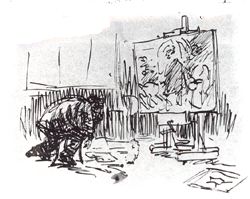 |
| 1870 | Born in Philadelphia. |
| 1890 | Graduates from Central High with a Bachelor of Arts degree. John Sloan and Albert Barnes are fellow students. |
| 1892 | Studies at the Pennsylvania Academy of Fine Arts and meets Robert Henri. |
| 1894 | Shares a studio with Henri and participates in his first exhibition. |
| 1895 | Takes a job illustrating books. Then quits and goes to Paris with Henri. |
| 1896 | Bicycles through Europe and studies the Dutch masters. Returns to the US and rents a studio in New York. |
| 1898 | Goes to Cuba to report on the Spanish-American War and twelve of his drawings of the war are published. |
| 1901 | Exhibits at the Allan Gallery with Henri, Sloan, and others. His works are well received. |
| 1903 | Receives a major commission to illustrate volumes by the writer Charles-Paul de Kock. |
| 1904 | Exhibits at a group show at the National Arts Club. Marries artist Edith Dimock. |
| 1905 | Paints 'Chez Mouquin' and wins an honorable mention at the Carnegie Institute. |
| 1907 | Submits several paintings to the National Academy and all but one is rejected. |
| 1908 | Exhibits with the group known as 'The Eight' and the show travels the eastern half of the US. |
| 1910 | Helps organize the 'Exhibition of Independent Artists'. It is the first "no jury-no prizes show held in America. |
| 1912 | Goes to Paris on a buying trip for Dr. Barnes. Buys a number of Impressionists works for the Doctor's collection. Has his first one man show at Madison Art Gallery. |
| 1913 | Is the chairman at the Armory Show. Has his second one man show. |
| 1914 | Begins to devote himself entirely to painting. |
| 1917 | Elected president of the Society of Independent Artists. Has two more one man shows. |
| 1919 | Illustrates his last story. |
| 1922 | Has a small one-artist show at the Whitney Studio Club. |
| 1924 | Recieves the Temple Gold Medal from the Pennsylvania Academy of the Fine Arts. |
| 1925 | Has his first show at Kraushaar Art Galleries; they are still his primary dealer to the present. Visits France. Health begins to deteriorate. |
| 1926 | Travels all over Europe. |
| 1927-30 | Spends his time between Paris and New York. Continues to paint. |
| 1931 | Has another show at Kraushaar Art Galleries. Still traveling between Paris and New York. |
| 1934 | Paints in Canada and Vermont. |
| 1935 | Has another show at Kraushaar Art Galleries. |
| 1937 | Reveives the Grand Prix at the Paris Exposition for 'Central Park, Winter'. |
| 1938 | Dies suddenly from a cerebral hemorrage. A number of memorial exhibits followed his death. |
